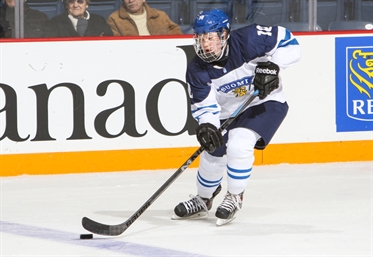Finland’s development program
Finland’s development program
Team Kuortane targets women’s hockey for U18

 ST. CATHARINES, CANADA - JANUARY 11: Finland's Eve Savander #10 skates the puck during preliminary round action against Team Sweden at the 2016 IIHF Ice Hockey U18 Women's World Championship. (Photo by Francois Laplante/HHOF-IIHF Images)
ST. CATHARINES, CANADA - JANUARY 11: Finland's Eve Savander #10 skates the puck during preliminary round action against Team Sweden at the 2016 IIHF Ice Hockey U18 Women's World Championship. (Photo by Francois Laplante/HHOF-IIHF Images)
It’s a curious name and one that means so much more than just one team in a league.
Indeed, Finland’s U18 coach, Jari Risku, is also Kuortane’s coach. For good reason.
“The Finnish Ice Hockey Federation started a program six years ago,” Risku explained. “Every year we try to collect our best girls from around the country to study in high school. We practice every day on ice, and they have classes every day. It’s like a university campus—everything is close. The dorms to the rink are 300 metres, and to the school just 150 metres. The focus is study, life skills, and sport. The youngest girls are 14 and they go up to age 18. This season, for the first time, we have three players who are in Grade 9, like Linnea Melotindos, who will start high school next year.”
Located in the southwest of Finland, about 350 km due north of Helsinki, Kuortane is a small city perfect for focusing on sports and education without much other distraction.
The program is a milestone initiative for Finland’s girls, something akin to the U.S. National Team Development Program for young men under 18. “The U.S. program is one of our models,” Risku continued, “and Finnish volleyball has been doing this for 15 years as well with great success.”
The development program for Finnish girls is impressively sophisticated and thorough. “We have a very good scouting system in Finland,” Risku said. “We start scouting them when they’re 11 or 12. Every month we bring them to Kuortane to play games and assess them. We have an under-16 program as well.”
The Finns have won only one medal at WW18, a bronze in 2011, but that is of little concern to Risku and the Finnish Federation. “The important part of their development isn’t even the under-18 team,” he elaborated. “They come to Kuortane only the previous August, so by the time of this tournament they’ve been here only four months. The ’98-born players have been here a year and a half, so the influence on them is much greater. But our goal is to develop them for the senior team. We want to win a medal here, of course, but the more important factor is preparing them for the senior level, to develop leaders and the skills they need to be a leader.”
Because women’s hockey doesn’t yet have the various components as do the men—the NHL, the draft, minor pro leagues—the girls who play under Risku are more focused on education and careers, and improving their hockey skills along the way.
“We especially try to help the girls who aspire to play in the NCAA,” Risku agreed. “I have some good contacts there and keep in touch with some of the coaches. They’ll come over to Kuortane to scout the girls and see how our program works. What they need and want is leadership. These girls are one or two years older than North Americans, so they want that leadership most of all.”
The program is still young but has already yielded several fine young players in this context. Anna Kilponen went on to play at North Dakota; Suvi Ollikainen is at St. Cloud; Saana Valkomaa played in Burlington, Vermont; Jenna Suokko went to Olds College.
It’s a burgeoning program, one that gains greater traction every year, and is sure in the long run to develop world-class players who one day can dream of Olympic gold.
Yes, gold.
Back to Overview









































